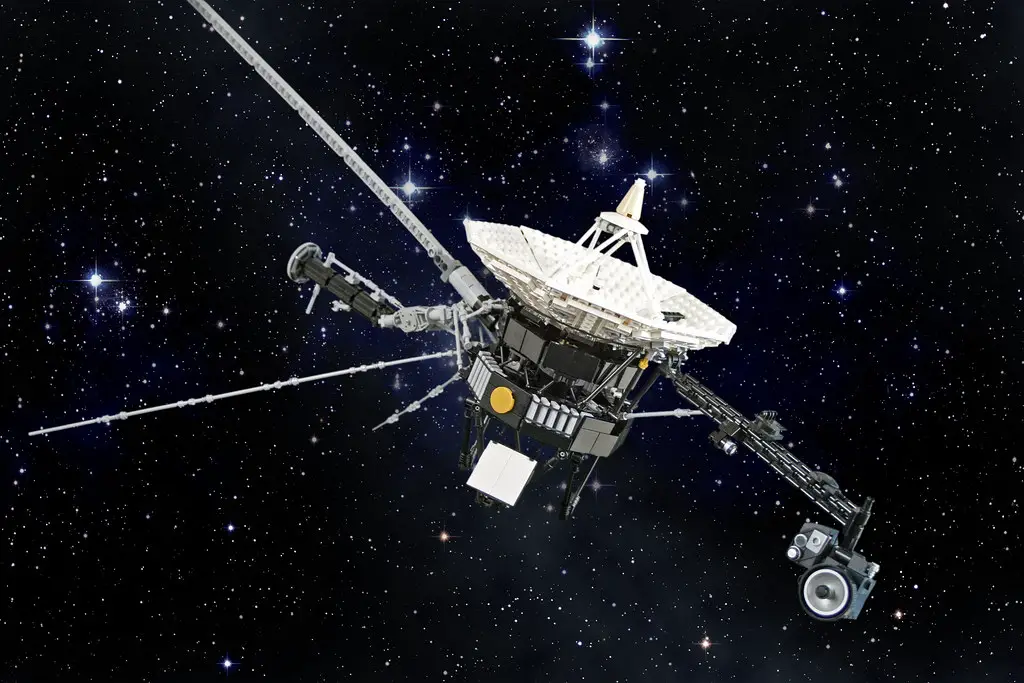Launched in 1977, Voyager 2 has been exploring the solar system for over 30 years and is still actively transmitting scientific data back to Earth. It passed by Jupiter in 1979, Saturn in 1980, and Uranus in 1986, sending information about each of these planets back to Earth. As of July 9, 2012, Voyager 2 was 14 billion kilometers (8 billion miles) from Earth and 4 billion kilometers (2 billion miles) from the Sun, traveling away from both at a speed of 17 kilometers per second (38,000 miles per hour). Its current path will take it into interstellar space in the coming years.
What is Voyager 2?
The Voyager Program sent two spacecraft to study Saturn, Jupiter, Uranus and Neptune. This twin probe mission was one of NASA’s most ambitious; it is still ongoing today with both probes still sending information back to Earth. The second of these probes, Voyager 2, headed out on its own in November 1990 and has been exploring space ever since. In 2012, it broke through our solar system’s heliosphere—the outermost layer of our sun’s sphere of influence—and into interstellar space. At time of writing (August 2013), Voyager 2 was more than 10 billion miles from Earth and traveling at a speed that would take it more than 70,000 years to reach Alpha Centauri, our closest star system neighbor.
How does this project works?
The Voyager 1 and Voyager 2 space probes were launched in 1977. The two spacecraft are robotic explorers, carrying a message from humankind to other worlds. In 2012, when Voyager 1 had entered interstellar space, it was re-designated as having left our solar system (interstellar medium) and entered a new region called transitional space. However, recent observations suggest that Voyager 1 may still be within our solar bubble and will not cross into interstellar space for several years. Scientists think Voyager 2 is also traveling through an unexplored region between our solar system and interstellar space. We can’t see either of these spacecraft now because they are too far away—about 11 billion miles (18 billion kilometers). But we can detect them using NASA’s Deep Space Network, which communicates with all of NASA’s interplanetary spacecraft. This is how we know their approximate locations and whether they have encountered any unusual activity since their launches.
How far away is Voyager 2 from Earth?
As of December 2018, Voyager 2 is about 141.6 astronomical units (AU) away from Earth. One AU is equal to 93 million miles (150 million kilometers). Voyager 1 and Voyager 2 are in interstellar space—which means they’re outside our solar system. The two spacecraft are exploring a giant bubble in our solar system called the heliosheath. The heliosheath marks where solar winds slow down as they push into interstellar space and where interstellar winds come into contact with our solar wind. Scientists have been tracking Voyager 2 since it left our solar system on August 25, 2012. That was when it officially entered interstellar space after traveling through a region called the heliosheath for almost 11 years. Its twin spacecraft, Voyager 1, entered interstellar space in 2012 after traveling through that region for 12 years. Since then, both Voyagers have been speeding toward deep space at 38,000 mph (61,155 kph). They will continue traveling outwards until their plutonium power sources die out between 2025 and 2030.
How long will it last?
Once its energy source—the sun—runs out, it will continue to travel through space at 38,000 miles per hour. The spacecraft has a radioactive battery that could keep it functional for as long as 170 years. But Voyager will start to slow down eventually and end up in interstellar space…never making contact with Earth again. That should happen around 40,000 AD. At that point, Voyager 2 is estimated to be about 21 billion miles from Earth. In terms of light-years, that’s more than 124 trillion miles away! That’s one small step for man…one giant leap for mankind.
The Voyagers Are Still Talking To Us
A little over a year ago, Voyager 1 (launched in 1977) left our solar system to explore interstellar space. Then, last November, its sister ship, Voyager 2 (launched in 1989), passed it to become our most distant spacecraft. Both spacecraft carry golden records—specially encoded gold-plated copper discs—that will hopefully outlive them by many thousands of years and communicate information about us to whoever happens across them first. They’re an awesome example of humans reaching beyond our current limitations. So what are they doing now? And how far away are they from Earth? Let’s find out!
![]()
